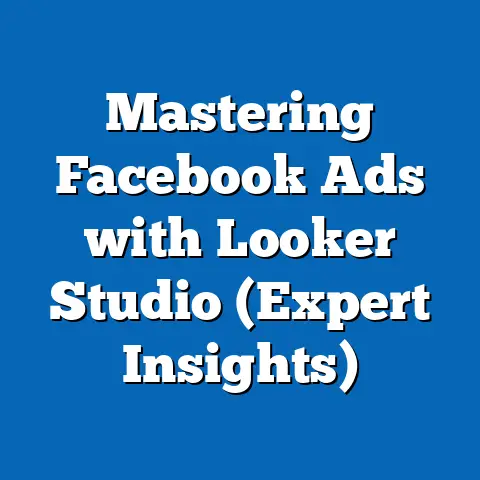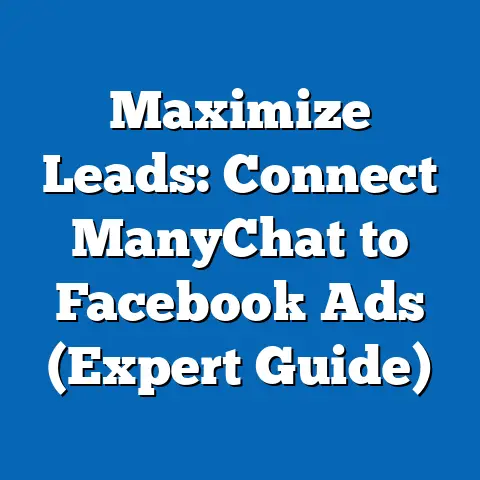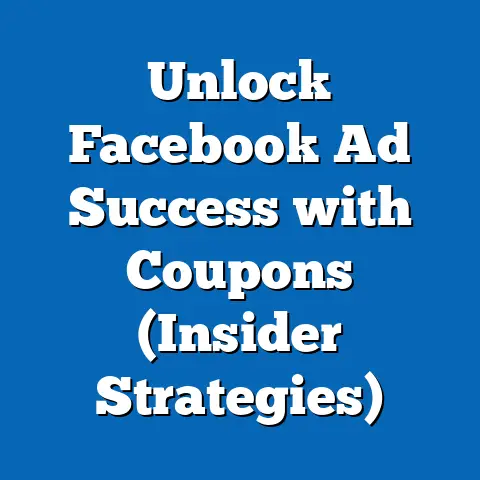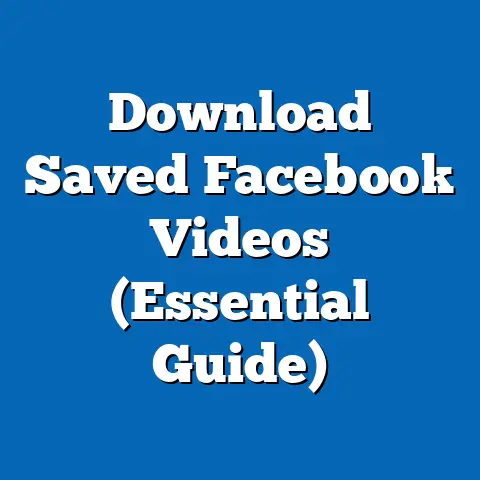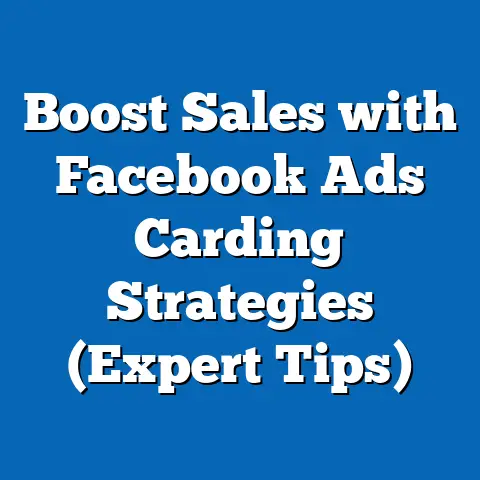Master Facebook Ad Arbitrage (Unlock Lucrative Strategies)
In today’s digital age, where online visibility can make or break a business, mastering the art of digital marketing is paramount. Among the myriad of strategies available, Facebook advertising stands out as a powerful tool for reaching a vast audience and driving targeted traffic. But what if you could leverage Facebook ads not just to promote your own products or services, but also to generate profit through a clever technique known as ad arbitrage? I’ve seen firsthand how transformative this can be, turning small initial investments into substantial returns.
Ad arbitrage, in its simplest form, is buying low and selling high – a concept that applies to various markets, including the digital realm. In the context of Facebook ads, it involves purchasing ad space at a low cost and directing that traffic to a platform or offer that generates a higher revenue per click or conversion. It’s a bit like being a digital landlord, renting out your ad space for a profit. The key to success lies in understanding the nuances of the Facebook Ads platform, identifying profitable niches, and continuously optimizing your campaigns.
Understanding Facebook Ad Arbitrage
What is Facebook Ad Arbitrage?
Facebook ad arbitrage is a strategy where you purchase ad space on Facebook at a certain cost and then direct the traffic generated from those ads to a different platform or offer where you earn more revenue than you spent on the ad itself. The “arbitrage” comes from exploiting the difference in value between the cost of traffic on Facebook and the revenue generated from that traffic elsewhere.
Think of it like this: you’re buying traffic wholesale on Facebook and selling it retail on another platform. The profit margin is the difference between your ad spend and the revenue generated.
How Does it Work?
The mechanics of Facebook ad arbitrage involve several key steps:
- Identify a Profitable Niche: This involves researching and identifying niches with high demand and relatively low ad costs.
- Create Compelling Ads: Craft ads that capture attention and entice users to click, driving traffic to your chosen platform.
- Target the Right Audience: Utilize Facebook’s targeting options to reach the most relevant audience for your offer, maximizing conversion rates.
-
Drive Traffic to Your Destination: Direct the traffic from your ads to a platform or offer that generates revenue, such as:
- Affiliate Marketing: Promoting affiliate products and earning a commission on each sale.
- Content Websites: Driving traffic to your own website and monetizing it through ads (e.g., Google AdSense).
- Lead Generation: Collecting leads for businesses and getting paid per lead.
- Track and Optimize: Continuously monitor your ad performance and make adjustments to improve your ROI.
Drive Traffic to Your Destination: Direct the traffic from your ads to a platform or offer that generates revenue, such as:
- Affiliate Marketing: Promoting affiliate products and earning a commission on each sale.
- Content Websites: Driving traffic to your own website and monetizing it through ads (e.g., Google AdSense).
- Lead Generation: Collecting leads for businesses and getting paid per lead.
- Track and Optimize: Continuously monitor your ad performance and make adjustments to improve your ROI.
The Importance of Understanding the Facebook Ads Platform
Success in Facebook ad arbitrage hinges on a deep understanding of the Facebook Ads platform. This includes:
- Targeting Options: Mastering Facebook’s detailed targeting options, including demographics, interests, behaviors, and connections. This allows you to reach the most relevant audience for your offer. I’ve spent countless hours experimenting with different targeting combinations to find the sweet spot where ad costs are low and conversion rates are high.
- Ad Formats: Understanding the different ad formats available (e.g., image ads, video ads, carousel ads, collection ads) and choosing the most effective format for your niche and offer.
- Bidding Strategies: Familiarizing yourself with Facebook’s bidding strategies (e.g., lowest cost, cost cap, target cost, bid cap) and selecting the optimal strategy to maximize your ROI. This is where a lot of people get tripped up. You need to understand how each bidding strategy works and how it impacts your ad delivery and costs.
Takeaway: Facebook ad arbitrage is about exploiting the difference between the cost of traffic on Facebook and the revenue generated from that traffic elsewhere. A thorough understanding of the Facebook Ads platform is crucial for success.
Setting Up for Success
Prerequisites for Successful Facebook Ad Arbitrage
Before diving into the world of Facebook ad arbitrage, it’s essential to lay a solid foundation. Here are the prerequisites for setting yourself up for success:
- Choosing the Right Niche and Understanding Your Audience: This is arguably the most critical step. You need to identify a niche that is both profitable and aligns with your interests or expertise. I’ve learned the hard way that passion projects don’t always translate into profitable ventures. Do your research! Look for niches with high demand, low competition, and a clear monetization strategy. Understanding your audience is equally important. Know their demographics, interests, pain points, and what motivates them to take action.
- Setting Up a Facebook Business Manager Account: A Facebook Business Manager account is essential for managing your ad accounts, pages, and other business assets. It provides a centralized platform for managing your advertising activities and collaborating with team members. I recommend setting this up even before you start planning your first campaign; it’s the foundation for everything you’ll do.
- Developing a Budget and Determining Your ROI Expectations: Ad arbitrage requires investment, so it’s crucial to set a budget and determine your ROI expectations upfront. Start with a small budget and gradually increase it as you gain experience and identify profitable campaigns. Be realistic about your ROI expectations, especially in the beginning. It takes time to optimize your campaigns and achieve consistent profitability.
The Importance of Research and Analytics
Research and analytics are the cornerstones of successful Facebook ad arbitrage. You need to continuously monitor your ad performance, analyze your data, and make adjustments to improve your ROI.
- Niche Research: Use tools like Google Trends, SEMrush, and Ahrefs to identify trending topics, keyword opportunities, and competitor strategies.
- Audience Research: Utilize Facebook Audience Insights to gain a deeper understanding of your target audience’s demographics, interests, and behaviors.
- Ad Performance Analytics: Track key metrics like CTR, CPC, conversion rates, and ROI using Facebook Ads Manager.
- Competitor Analysis: Monitor your competitors’ ads and strategies using tools like AdEspresso Ad Gallery and Facebook Ad Library.
Takeaway: Setting up for success in Facebook ad arbitrage requires careful planning, thorough research, and a strong understanding of your audience and the market.
Crafting High-Converting Ads
Elements of a Successful Facebook Ad
Crafting high-converting ads is the art of turning casual scrollers into engaged customers. It’s not just about having a pretty picture; it’s about understanding what makes your audience tick and speaking directly to their needs and desires. Here are the key elements:
- Compelling Headlines and Copywriting Techniques: Your headline is the first thing people see, so it needs to grab their attention and pique their interest. Use strong verbs, numbers, and emotional language to create a sense of urgency and excitement. The body copy should clearly articulate the benefits of your offer and address any potential objections. I always try to keep my headlines short and sweet, focusing on the core value proposition.
- Eye-Catching Visuals and Videos: Visuals are crucial for capturing attention in a crowded newsfeed. Use high-quality images or videos that are relevant to your offer and appeal to your target audience. Experiment with different types of visuals to see what performs best. I’ve found that videos often outperform images, especially when they tell a compelling story or demonstrate the value of your product or service.
- Call-to-Action (CTA) Strategies: Your CTA is the final nudge that encourages people to take action. Use clear and concise language that tells people exactly what you want them to do (e.g., “Shop Now,” “Learn More,” “Sign Up”). Experiment with different CTAs to see what drives the most clicks and conversions. I often use a sense of urgency in my CTAs, such as “Limited Time Offer” or “Get Yours Now.”
Examples of Effective Ads
To illustrate these principles, let’s look at some examples of effective ads that have performed well in various niches:
- E-commerce: An ad for a clothing brand might feature a high-quality image of a model wearing the product, with a headline like “Get 20% Off Your First Order!” and a CTA like “Shop Now.”
- Affiliate Marketing: An ad promoting a weight loss program might feature a before-and-after photo, with a headline like “Lose Weight Fast and Easy!” and a CTA like “Learn More.”
- Lead Generation: An ad offering a free e-book on digital marketing might feature an image of the e-book cover, with a headline like “Download Your Free Digital Marketing Guide!” and a CTA like “Sign Up.”
Takeaway: Crafting high-converting ads requires a combination of compelling copywriting, eye-catching visuals, and strategic call-to-actions.
Targeting and Audience Segmentation
Leveraging Facebook’s Targeting Capabilities
Facebook’s targeting capabilities are what truly set it apart from other advertising platforms. The ability to pinpoint your ideal customer with laser-like precision is a game-changer for ad arbitrage.
- Demographics: Target users based on age, gender, location, education, job title, and other demographic factors.
- Interests: Target users based on their interests, hobbies, and passions. This is where you can really get granular and target specific communities or subcultures.
- Behaviors: Target users based on their online behavior, such as purchase history, website visits, and app usage.
- Connections: Target users based on their connections to your Facebook page or app.
Custom Audiences and Lookalike Audiences
- Custom Audiences: These are audiences you create based on your own data, such as customer lists, website visitors, and app users. You can upload your customer list to Facebook and target those users directly with your ads. You can also create custom audiences based on people who have visited your website or interacted with your app. I’ve found that targeting custom audiences is one of the most effective ways to drive conversions.
- Lookalike Audiences: These are audiences that Facebook creates based on your custom audiences. Facebook analyzes the characteristics of your custom audience and finds other users who are similar to them. This is a great way to expand your reach and find new customers who are likely to be interested in your offer.
Retargeting Strategies
Retargeting is the art of re-engaging potential customers who have already shown interest in your product or service. This can be done by showing ads to people who have visited your website, added items to their cart, or watched a video on your Facebook page.
Takeaway: Mastering Facebook’s targeting capabilities is essential for maximizing ad performance and achieving a high ROI in ad arbitrage.
Monitoring and Optimizing Campaigns
The Importance of Continuous Monitoring
In the world of Facebook ad arbitrage, setting up your campaign and walking away is a recipe for disaster. Continuous monitoring is critical to ensure that your ads are performing optimally and that you’re getting the best possible ROI.
Key Metrics to Track
Here are some key metrics to track in Facebook Ads Manager:
- CTR (Click-Through Rate): This is the percentage of people who see your ad and click on it. A high CTR indicates that your ad is relevant and engaging to your target audience.
- CPC (Cost Per Click): This is the amount you pay each time someone clicks on your ad. A low CPC indicates that your ad is efficient and that you’re getting good value for your money.
- Conversion Rate: This is the percentage of people who click on your ad and then take the desired action (e.g., make a purchase, sign up for a newsletter). A high conversion rate indicates that your offer is compelling and that your landing page is effective.
- ROI (Return on Investment): This is the ultimate measure of your campaign’s success. It tells you how much profit you’re generating for every dollar you spend on advertising.
A/B Testing Strategies
A/B testing is the process of comparing two versions of an ad or landing page to see which one performs better. This is a crucial step in optimizing your campaigns and improving your ROI.
Takeaway: Continuous monitoring and optimization are essential for maximizing your ROI in Facebook ad arbitrage.
Scaling Your Facebook Ad Arbitrage Business
Scaling Successful Campaigns
Once you’ve identified a profitable campaign, the next step is to scale it up and increase your profits. This can be done by increasing your ad spend, expanding your targeting, or launching new campaigns based on your successful formula.
Automation Tools and Software
As you scale your business, it’s important to leverage automation tools and software to streamline your operations and save time. There are many tools available that can help you automate tasks like ad creation, campaign management, and reporting.
Reinvesting Profits
The key to long-term success in Facebook ad arbitrage is to reinvest your profits back into your business. This can be done by expanding your ad spend, exploring new niches, or investing in tools and resources that will help you improve your performance.
Takeaway: Scaling your Facebook ad arbitrage business requires a combination of strategic planning, efficient execution, and continuous reinvestment.
Conclusion
Facebook ad arbitrage presents a compelling opportunity for marketers seeking to generate a lucrative income stream. By understanding the mechanics of arbitrage, mastering the Facebook Ads platform, and continuously optimizing your campaigns, you can unlock the potential to turn small investments into substantial profits. Remember, success in ad arbitrage requires dedication, persistence, and a willingness to learn and adapt. So, take the strategies outlined in this guide, put them into action, and embark on your journey to mastering Facebook ad arbitrage. The digital landscape is vast and ever-changing, but with the right knowledge and approach, you can carve out your own path to financial success. Good luck, and happy advertising!

